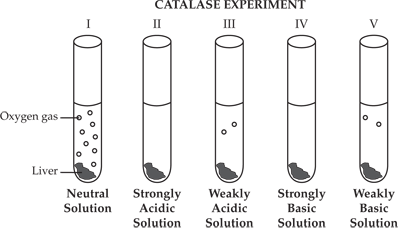Chemistry Of Life - Quiz 2
(281).jpg)
The is our second online quiz for "The Chemistry of Life" unit.
Orange juice is a common acid.
Questions and Answers
- 1.
The neutral pH value is _______.
- A.
8
- B.
9
- C.
10
- D.
7
Correct Answer
D. 7Explanation
The neutral pH value is 7. This is because the pH scale ranges from 0 to 14, with 7 being the midpoint. A pH value of 7 indicates a neutral solution, meaning it is neither acidic nor alkaline. It is important to note that pH values below 7 are acidic, while values above 7 are alkaline.Rate this question:
-
- 2.
In a salt water solution, water is the ________.
- A.
Solute
- B.
Solvent
- C.
Base
- D.
Acid
Correct Answer
B. SolventExplanation
In a salt water solution, the solute is the salt, while the solvent is the water. The solute is the substance that is being dissolved, while the solvent is the substance in which the solute is dissolved. In this case, the salt is being dissolved in water, therefore water is the solvent.Rate this question:
-
- 3.
Isotopes differ in the number of __________.
- A.
Protons
- B.
Atoms
- C.
Electrons
- D.
Neutrons
Correct Answer
D. NeutronsExplanation
Isotopes are atoms of the same element that have different numbers of neutrons. Neutrons are subatomic particles that have no charge and are found in the nucleus of an atom along with protons. The number of protons in an atom determines its atomic number and defines the element, while the number of neutrons can vary among isotopes of the same element. Therefore, the correct answer is neutrons.Rate this question:
-
- 4.
A covalent bond is formed by the
- A.
Transfer of electrons
- B.
Sharing of electrons
- C.
Gaining of electrons
- D.
Losing electrons
Correct Answer
B. Sharing of electronsExplanation
A covalent bond is formed by the sharing of electrons between two atoms. In this type of bond, both atoms contribute one or more electrons to a shared electron pair, resulting in a stable arrangement. This sharing allows both atoms to achieve a full outer electron shell, similar to the noble gases, making the bond strong and stable.Rate this question:
-
- 5.
Proteins are made up of
- A.
Lipids
- B.
Amino acids
- C.
Carbohydrates
- D.
Nucleic acids
Correct Answer
B. Amino acidsExplanation
Proteins are macromolecules made up of amino acids. Amino acids are the building blocks of proteins and are linked together through peptide bonds to form long chains. These chains then fold into specific three-dimensional structures, which determine the protein's function. Lipids, carbohydrates, and nucleic acids are all important biomolecules, but they are not the primary components of proteins.Rate this question:
-
- 6.
In the early 1900s, many children had a disease called rickets. Research showed that the children had a deficiency of a vitamin that is necessary for the proper formation of bones. Which of these vitamins was lacking in the diets of these children?(from www.mdk12.org)
- A.
Vitamin A
- B.
Vitamin C
- C.
Vitamin D
- D.
Vitamin k
Correct Answer
C. Vitamin DExplanation
In the early 1900s, many children had a disease called rickets, which is characterized by weak and deformed bones. Research showed that these children had a deficiency of a vitamin necessary for proper bone formation. Vitamin D is crucial for the absorption of calcium and phosphorus, which are essential for bone health. Therefore, the lack of Vitamin D in the diets of these children led to the development of rickets.Rate this question:
-
- 7.
(from www.mdk12.org)Use the information and the diagram below to answer the following item. Catalase is an enzyme found in the tissues of plants and animals, including humans. Catalase helps prevent a toxic buildup of hydrogen peroxide in cells by breaking it down into water and oxygen gas. Several students conduct an experiment to test the effects of pH on the activity of catalase. Each test tube contains a solution of hydrogen peroxide and water at various pH levels. The liver tissue is a source of catalase. The diagram below represents the results of their experiment. Based on the students’ results, catalase works best at a pH of
- A.
1
- B.
4
- C.
7
- D.
10
Correct Answer
C. 7Explanation
The diagram shows that the highest level of activity for catalase occurs at a pH of 7. This means that catalase is most effective at a neutral pH. At lower or higher pH levels, the activity of catalase decreases. This suggests that catalase has an optimal pH range in which it functions most efficiently.Rate this question:
-
- 8.
Use the information and the diagram below to answer the following item. Catalase is an enzyme found in the tissues of plants and animals, including humans. Catalase helps prevent a toxic buildup of hydrogen peroxide in cells by breaking it down into water and oxygen gas. Several students conduct an experiment to test the effects of pH on the activity of catalase. Each test tube contains a solution of hydrogen peroxide and water at various pH levels. The liver tissue is a source of catalase. The diagram below represents the results of their experiment.Which of the following are the building blocks of catalase?
- A.
Monosaccharides
- B.
Nucleic acids
- C.
Vitamins
- D.
Amino acids
Correct Answer
D. Amino acidsExplanation
Catalase is an enzyme, which is a type of protein. Proteins are made up of chains of amino acids. Therefore, the building blocks of catalase are amino acids.Rate this question:
-
Quiz Review Timeline +
Our quizzes are rigorously reviewed, monitored and continuously updated by our expert board to maintain accuracy, relevance, and timeliness.
-
Current Version
-
Mar 22, 2023Quiz Edited by
ProProfs Editorial Team -
Nov 16, 2009Quiz Created by
Akimamarshall
 Back to top
Back to top



